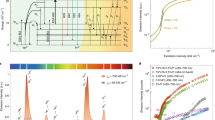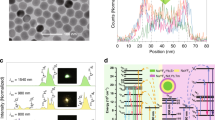Abstract
Lanthanide-doped nanocrystals have been actively pursued as anti-Stokes emitters in various contexts, including bioimaging, photovoltaics, catalysis, displays, anticounterfeiting, sensing and lasers. The success of these applications crucially relies on their high brightness under low excitation. To enhance their upconversion luminescence, researchers have improved the internal material properties of nanocrystals (their composition, doping, and crystal and surface structures) and, in parallel, engineered external optical responses using plasmonic couplings. However, despite impressive progress, upconversion brightness still falls short of what is required for applications, and a systematic understanding of plasmon-enhanced upconversion remains elusive. Here we report an important conceptual advance in understanding and demonstrate unprecedentedly bright upconversion of single nanocrystals via coupling to a single plasmonic nanocavity mode. We present in situ-controlled single-nanocrystal-level studies with unified internal and external treatment, and unambiguously experimentally demonstrate the phenomenon of plasmonic enhancement saturation. We show that the saturation is doping-dependent, and we report a 2.3 × 105-fold enhancement of upconversion luminescence. More importantly, we outline a new strategy to devise ultrabright upconversion nanomaterials and demonstrate that single sub-30-nm nanocrystals can provide up to 560 detected photons per second at an ultralow excitation intensity of 0.45 W cm−2. These findings help to establish the link between the optical physics and material science in lanthanide-doped nanocrystals and facilitate the engineering of optimal upconversion nanomaterials for various applications.
This is a preview of subscription content, access via your institution
Access options
Access Nature and 54 other Nature Portfolio journals
Get Nature+, our best-value online-access subscription
$29.99 / 30 days
cancel any time
Subscribe to this journal
Receive 12 print issues and online access
$209.00 per year
only $17.42 per issue
Buy this article
- Purchase on Springer Link
- Instant access to full article PDF
Prices may be subject to local taxes which are calculated during checkout





Similar content being viewed by others
Data availability
The data that support the findings of this study are available from the corresponding authors upon reasonable request.
Code availability
All codes used in this paper are available from the corresponding authors upon reasonable request.
References
Zhou, B., Shi, B., Jin, D. & Liu, X. Controlling upconversion nanocrystals for emerging applications. Nat. Nanotechnol. 10, 924–936 (2015).
Chen, G., Ågren, H., Ohulchanskyy, T. Y. & Prasad, P. N. Light upconverting core-shell nanostructures: nanophotonic control for emerging applications. Chem. Soc. Rev. 44, 1680–1713 (2015).
Casar, J. R., McLellan, C. A., Siefe, C. & Dionne, J. A. Lanthanide-based nanosensors: refining nanoparticle responsiveness for single particle imaging of stimuli. ACS Photonics 8, 3–17 (2021).
Auzel, F. Upconversion and anti-Stokes processes with f and d ions in solids. Chem. Rev. 104, 139–174 (2004).
Wen, S. et al. Advances in highly doped upconversion nanoparticles. Nat. Commun. 9, 2415 (2018).
Han, S., Deng, R., Xie, X. & Liu, X. Enhancing luminescence in lanthanide-doped upconversion nanoparticles. Angew. Chem. Int. Ed. 53, 11702–11715 (2014).
Gargas, D. J. et al. Engineering bright sub-10-nm upconverting nanocrystals for single-molecule imaging. Nat. Nanotechnol. 9, 300–305 (2014).
Liu, Q. et al. Single upconversion nanoparticle imaging at sub-10 W cm−2 irradiance. Nat. Photon. 12, 548–553 (2018).
Wang, F. et al. Tuning upconversion through energy migration in core–shell nanoparticles. Nat. Mater. 10, 968–973 (2011).
Wu, D. M., Garcia-Etxarri, A., Salleo, A. & Dionne, J. A. Plasmon-enhanced upconversion. J. Phys. Chem. Lett. 5, 4020–4031 (2014).
Park, W., Lu, D. & Ahn, S. Plasmon enhancement of luminescence upconversion. Chem. Soc. Rev. 44, 2940–2962 (2015).
Qin, X. et al. Surface plasmon-photon coupling in lanthanide-doped nanoparticles. J. Phys. Chem. Lett. 12, 1520–1541 (2021).
Lalanne, P., Yan, W., Vynck, K., Sauvan, C. & Hugonin, J. P. Light interaction with photonic and plasmonic resonances. Laser Photon. Rev. 12, 1700113 (2018).
Aisaka, T., Fujii, M. & Hayashi, S. Enhancement of upconversion luminescence of Er doped Al2O3 films by Ag island films. Appl. Phys. Lett. 92, 132105 (2008).
Esteban, R., Laroche, M. & Greffet, J. J. Influence of metallic nanoparticles on upconversion processes. J. Appl. Phys. 105, 033107 (2009).
Schietinger, S., Aichele, T., Wang, H. Q., Nann, T. & Benson, O. Plasmon-enhanced upconversion in single NaYF4:Yb3+/Er3+ codoped nanocrystals. Nano Lett. 10, 134–138 (2010).
Zhang, H. et al. Plasmonic modulation of the upconversion fluorescence in NaYF4:Yb/Tm hexaplate nanocrystals using gold nanoparticles or nanoshells. Angew. Chem. Int. Ed. 49, 2865–2868 (2010).
Deng, W. et al. Ultrabright Eu-doped plasmonic Ag@SiO2 nanostructures: time-gated bioprobes with single particle sensitivity and negligible background. Adv. Mater. 23, 4649–4654 (2011).
Zhang, W., Ding, F. & Chou, S. Y. Large enhancement of upconversion luminescence of NaYF4:Yb3+/Er3+ nanocrystal by 3D plasmonic nano-antennas. Adv. Opt. Mater. 24, OP236–OP241 (2012).
Zhan, Q. Q., Zhang, X., Zhao, Y. X., Liu, J. & He, S. L. Tens of thousands-fold upconversion luminescence enhancement induced by a single gold nanorod. Laser Photon. Rev. 9, 479–487 (2015).
Greybush, N. J. et al. Plasmon-enhanced upconversion luminescence in single nanophosphor-nanorod heterodimers formed through template-assisted self-assembly. ACS Nano 8, 9482–9491 (2014).
Chen, G. et al. Tip-enhanced upconversion luminescence in Yb3+-Er3+ codoped NaYF4 nanocrystals. J. Phys. Chem. C 119, 22604–22610 (2015).
Mauser, N. et al. Tip enhancement of upconversion photoluminescence from rare earth ion doped nanocrystals. ACS Nano 9, 3617–3626 (2015).
Yin, Z. et al. Local field modulation induced three-order upconversion enhancement: combining surface plasmon effect and photonic crystal effect. Adv. Mater. 28, 2518–2525 (2016).
Kwon, S. J. et al. A plasmonic platform with disordered array of metal nanoparticles for three-order enhanced upconversion luminescence and highly sensitive near-infrared photodetector. Adv. Mater. 28, 7899–7909 (2016).
Kang, F. W. et al. Plasmonic dual-enhancement and precise color tuning of gold Nanorod@SiO2 coupled core-shell-shell upconversion nanocrystals. Adv. Funct. Mater. 27, 1701842 (2017).
Xue, Y. X. et al. Tuning plasmonic enhancement of single nanocrystal upconversion luminescence by varying gold nanorod diameter. Small 13, 1701155 (2017).
Das, A., Mao, C., Cho, S., Kim, K. & Park, W. Over 1,000-fold enhancement of upconversion luminescence using water-dispersible metal–insulator–metal nanostructures. Nat. Commun. 9, 4828 (2018).
Wu, Y. et al. Upconversion superburst with sub-2-μs lifetime. Nat. Nanotechnol. 14, 1110–1115 (2019).
Alizadehkhaledi, A. et al. Cascaded plasmon-enhanced emission from a single upconverting nanocrystal. ACS Photonics 6, 1125–1131 (2019).
Xu, J. H. et al. Multiphoton upconversion enhanced by deep subwavelength near-field confinement. Nano Lett. 21, 3044–3051 (2021).
Malta, O. L. Mechanisms of non-radiative energy transfer involving lanthanide ions revisited. J. Non-Cryst. Solids 354, 4770–4776 (2008).
Purcell, E. M. Spontaneous emission probabilities at radio frequencies. Phys. Rev. 69, 681 (1946).
Rabouw, F. T. et al. Quenching pathways in NaYF4:Er3+,Yb3+ upconversion nanocrystals. ACS Nano 12, 4812–4823 (2018).
Nadort, A., Zhao, J. B. & Goldys, E. M. Lanthanide upconversion luminescence at the nanoscale: fundamentals and optical properties. Nanoscale 8, 13099–13130 (2016).
Fischer, S., Bronstein, N. D., Swabeck, J. K., Chan, E. M. & Alivisatos, A. P. Precise tuning of surface quenching for luminescence enhancement in core-shell lanthanide-doped nanocrystals. Nano Lett. 16, 7241–7247 (2016).
Potton, R. J. Reciprocity in optics. Rep. Prog. Phys. 67, 717–754 (2004).
Shafiei, F. et al. A subwavelength plasmonic metamolecule exhibiting magnetic-based optical Fano resonance. Nat. Nanotechnol. 8, 95–99 (2013).
Wen, T. et al. Steering valley-polarized emission of monolayer MoS2 sandwiched in plasmonic antennas. Sci. Adv. 6, eaao0019 (2020).
Taminiau, T. H., Stefani, F. D., Segerink, F. B. & Van Hulst, N. F. Optical antennas direct single-molecule emission. Nat. Photon. 2, 234–237 (2008).
Lieb, M. A., Zavislan, J. M. & Novotny, L. Single-molecule orientations determined by direct emission pattern imaging. J. Opt. Soc. Am. B 21, 1210–1215 (2004).
Peng, X. et al. Fast upconversion super-resolution microscopy with 10 μs per pixel dwell times. Nanoscale 11, 1563–1569 (2019).
Ma, C. et al. Optimal sensitizer concentration in single upconversion nanocrystals. Nano Lett. 17, 2858–2864 (2017).
Braud, A. et al. Energy-transfer processes in Yb:Tm-doped KY3F10, LiYF4 and BaY2F8 single crystals for laser operation at 1.5 and 2.3 μm. Phys. Rev. B 61, 5280–5292 (2000).
Zhang, T. S., Gao, N. Y., Li, S., Lang, M. J. & Xu, Q. H. Single-particle spectroscopic study on fluorescence enhancement by plasmon coupled gold nanorod dimers assembled on DNA origami. J. Phys. Chem. Lett. 6, 2043–2049 (2015).
Nicoli, F. et al. DNA-mediated self-assembly of plasmonic antennas with a single quantum dot in the hot spot. Small 15, 1804418 (2019).
Wang, X. D. et al. High-sensitivity sensing of divalent copper ions at the single upconversion nanoparticle level. Anal. Chem. 93, 11686–11691 (2021).
Shang, Y. et al. Low threshold lasing emissions from a single upconversion nanocrystal. Nat. Commun. 11, 6156 (2020).
Koenderink, A. F., Alù, A. & Polman, A. Nanophotonics: shrinking light-based technology. Science 348, 516–521 (2015).
Koenderink, A. F. Single-photon nanoantennas. ACS Photonics 4, 710–722 (2017).
Acknowledgements
We gratefully acknowledge financial support from the National Natural Science Foundation of China (grant no. 11874166 to X.-W.C., 92150111 to X.-W.C., 62235006 to X.-W.C., 12004130 to J.T., 51972084 to G.C., 52272270 to G. C. and 51672061 to G.C.), the Fundamental Research Funds for the Central Universities, China (AUGA5710052614 to G.C.), the State Key Laboratory of Urban Water Resource and Environment (Harbin Institute of Technology; no. 2020DX10 to G.C.) and Huazhong University of Science and Technology (X.-W.C. and J.T.).
Author information
Authors and Affiliations
Contributions
X.-W.C. conceived the research. X.-W.C., G.C. and J.T. designed the experiment. Y.M., J.T., X.F., T.M. and J.H. carried out the UCNC–nanocavity coupling experiment and optical measurements. D.H. and F.L. synthesized and characterized the UCNC samples under the guidance of G.C. J.T., X.-W.C., H.L., Q.L. and J.H. developed the theoretical model and performed numerical simulations. X.-W.C., G.C., J.T. and Y.M. discussed the results and analysed data. The paper was written by X.-W.C. and J.T., and comments were provided by Y.M. and G.C. The project was supervised by X.-W.C., J.T. and G.C.
Corresponding authors
Ethics declarations
Competing interests
The authors declare no competing interests.
Peer review
Peer review information
Nature Photonics thanks Steven Chu, Aitzol García-Etxarri and Xiaogang Liu for their contribution to the peer review of this work.
Additional information
Publisher’s note Springer Nature remains neutral with regard to jurisdictional claims in published maps and institutional affiliations.
Supplementary information
Supplementary Information
Supplementary Figs. 1–33, Discussion and Tables 1–5.
Rights and permissions
Springer Nature or its licensor holds exclusive rights to this article under a publishing agreement with the author(s) or other rightsholder(s); author self-archiving of the accepted manuscript version of this article is solely governed by the terms of such publishing agreement and applicable law.
About this article
Cite this article
Meng, Y., Huang, D., Li, H. et al. Bright single-nanocrystal upconversion at sub 0.5 W cm−2 irradiance via coupling to single nanocavity mode. Nat. Photon. 17, 73–81 (2023). https://doi.org/10.1038/s41566-022-01101-z
Received:
Accepted:
Published:
Issue Date:
DOI: https://doi.org/10.1038/s41566-022-01101-z



